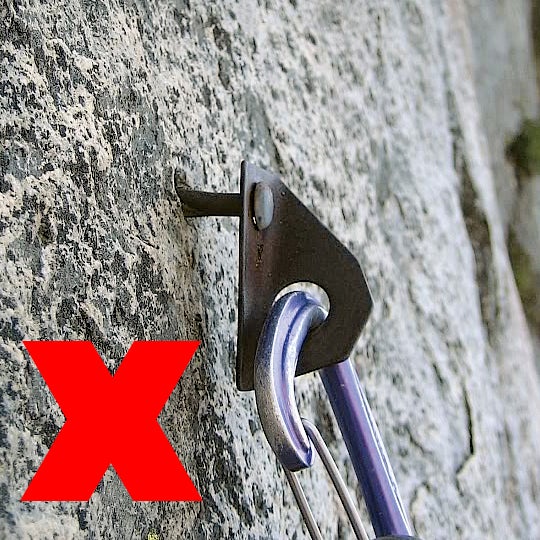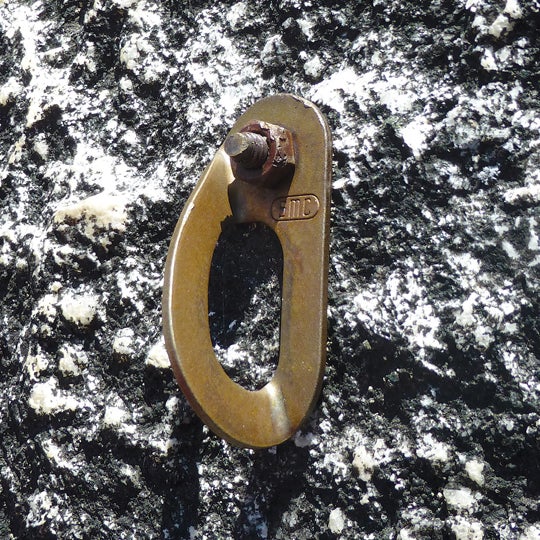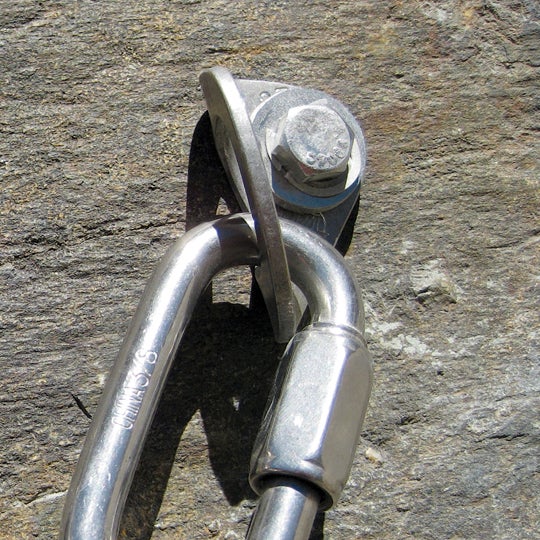Heading out the door? Read this article on the new Outside+ app available now on iOS devices for members! Download the app.
When we encounter a bolt, we often have no idea whether it’s good, bad, or just ugly. The reality is, bolts can fail due to metal fatigue, oxidation, improper placement, or hidden internal processes like stress corrosion cracking (SCC), in which tiny fissures form in the metal due to chemical reactions. While the design and construction of modern bolts make this a rarity on, say, routes from the past decade, older bolts with smaller diameters can fail. Identifying these bolts can help you assess the risk in clipping and making that next move. I’ve been rebolting for 30 years, and have replaced almost 1,000 bolts. Some old bolts looked great, while others have broken with a flick of the rope. Knowing the difference can save your life.
Bad Bolts

A bolt can be bad either because the rock is bad, the bolt is bad, or if it really isn’t your day, both are bad. To a large degree, the compressive strength—the force that the rock can withstand before breaking—varies by rock type. Granite tends to be the strongest, holding between 4,000 and 40,000 pounds. Good sandstone ranges from 1,000 to 20,000 pounds. And limestone typically holds between 1,000 and 5,000 pounds. In general, be cautious when the rock around the hole has broken away, exposing the bolt. If the stone is fractured, there are spider-web cracks leading from the bolt hole, or if the surrounding rock is hollow (tap it with a knuckle or carabiner to see if it reverberates), the strength can be compromised.
At times, the nut or head of the bolt that holds the hanger to the rock can be loose, causing a “spinner.” In this case, finger-tighten the nut or bolt, which will make the bolt adequate for the moment. Carrying a small, adjustable wrench helps in these circumstances—only tighten until it becomes significantly more difficult to turn the wrench past a logical “yield point,” lest the metal fatigue or snap.
If the bolt sticks out of the rock and cannot be tightened, place a wired stopper between the hanger and the rock to reduce leverage and increase strength. Clip the wire, not the hanger, and climb carefully, as falling on it may be dangerous. As with any suspect bolt, using a load-limiting device such as a Screamer might help. If there is a traditional gear placement available as a back-up, put in some extra gear.
Bad Hangers

In some circumstances, the bolt is good but the hanger is bad. The first step in judging a hanger’s trustworthiness is identifying the manufacturer. Many hangers produced before the mid-1980s can be suspect. There are two in particular to beware: Leeper hangers and SMC hangers. Unfortunately, the manufacturer of the Leeper hanger, of which 95,000 were produced from 1962 to 1984, noted their potential failure due to their susceptibility to SCC. Meanwhile, the slim-profile SMC chromoly hangers from the 1970s were prone to cracking and then breaking under load, resulting in climber deaths: These had a horizontal logo. In the 1980s, SMC beefed up their design with a stainless-steel version, which has a vertically oriented logo. If you see an SMC logo, think, “Sideways is bad, but up is good.” Also, homemade hangers, even though they may contain a lot of metal, have unknown manufacturing processes. These hangers should be treated as suspect; replacement is mandatory.
Mixing metals—i.e., pairing a stainless-steel bolt with a zinc-plated hanger and vice versa—can accelerate deterioration. (Stainless has a dull, gunmetal grey color, while plated is bright silver or almost blue.) Always use like metals, with a preference toward stainless steel, which lasts longer than plated steel. Ideally, the bolt-and-hanger combo will be both stainless and use modern hardware from Petzl, Fixe, Metolius, Climb Tech, and other reputable manufacturers.
Read More: The Actual Cost of Rebolting
Bolting Breakdown
American climbers first started using bolts in the 1930s. Since then, our technology has evolved, but many original bolts are still in place. The sidebar at right provides a guide, from worst to best.
Rebolting Efforts

Through the efforts of the UIAA and the Access Fund, there have been big advancements in developing best practices. National rebolting initiatives include the American Safe Climbing Association, and the American Alpine Club and Access Fund’s Anchor Replacement Fund. These organizations and a small group of dedicated rebolters have greatly increased the use of safer, long-lasting hardware. Many climbing areas and climbing websites also have systems in place for reporting suspect bolts and hangers. Take the time to report any such bolts you encounter to your local climber organization, on Mountain Project, or at badbolts.com—it is a critical community service.
- Want to push yourself harder above bolts? Join pro climber Madaleine Sorkin as she guides you through our 4 Weeks to Sending Fitness course, with shape-up exercises from fingerboarding to core blasters to endurance training and more. Visit 4 Weeks to Sending Fitness.
Hardware Sizes through the Ages
1/4” bolts

Popular in the 1950s through the mid-80s, “quarter-inchers” came in three basic styles. The most popular, the Rawl drive (aka split shaft), a compression bolt, used either a buttonhead or a threaded shaft and nut. Manufacturers designed this bolt for hard rock such as granite. Less popular were ¼” wedge bolts and Star Dryvins. Most Star Dryvins have a star pattern on the head of the “bolt,” which is actually a ¼” nail driven into a lead-lined sleeve. As with all ¼” bolts, it’s not just the small diameter but also the age of these bolts that makes them dangerous.
5/16” bolts

In the late 1980s and early 90s, climbers used 5/16” Rawl buttonheads for bolting on lead. Unfortunately, these are prone to breakage where the buttonhead meets the shaft. The head of these bolts looks like half an M&M. As with ¼” bolts, avoid trusting your life to a single one.
3/8” bolts

When sport climbing exploded in the 1980s, 3/8” bolts became popular. The two most popular designs are wedge bolts and the Powers/Rawl (aka “5-piece”) bolts. Wedge bolts have a long, threaded shaft with a nut on the end. The Powers 5-piece is identified by a hex-head bolt with three straight lines on the head for the plated-steel version and no distinguishing mark for stainless. (See “Rebolting Efforts,” for an SS bolt; bolt above is a 3/8” buttonhead.)
Meanwhile, 3/8” SS glue-in bolts have found their way to America. Glue-in bolts require more care to install—specifically, cleaning the hole properly and using the correct adhesive. In environments with a lot of water and/or salt, titanium glue-ins are the safest solution to prevent rust and SCC.
1/2” bolts

The most commonly used are Powers 5-piece and wedge bolts, which are larger versions of their 3/8” counterparts. Also popular are glue-ins. These larger bolts are used in harsh environments where the titanium versions resist corrosion better than
SS or on popular routes that see lots of falls where a traditional bolt could begin to loosen, or even spin because of side loading.
Read More: The Bad Bolt Club: 10 Sketchy Bolt Types That You Might Be Better Off Not Clipping
Bruce Hildenbrand has replaced bolts for the past 30 years in Pinnacles National Park, in Yosemite National Park, and all along Colorado’s Front Range.
READ ALL SAFETY FIRST ARTICLES
Is Trad More Dangerous Than Sport Climbing?